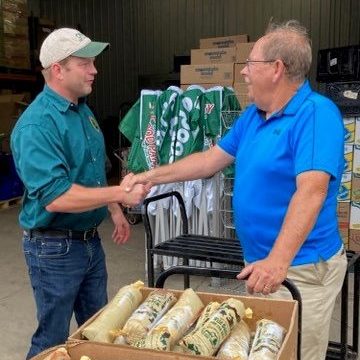Through a partnership with the Michigan Department of Natural Resources (MDNR), the Edward Lowe Foundation is donating venison to local food banks.
For nearly four decades, the foundation has conducted some form of deer management program at Big Rock Valley (BRV), its 2,000-acre property in southwest Michigan. “Like any animal, deer need to eat. And they eat a lot — about 6-8% of their body weight on a daily basis, which amounts to about 10 pounds of vegetation,” says Jarod Reibel, the foundation’s director of physical resources. “If there are only a few animals on the landscape, deer browsing isn’t overly detrimental, but that changes when there are many mouths to feed.”

In ecology, the term ‘carrying capacity’ refers to the amount of a particular species that the landscape can support, Reibel continues: “Prior to our deer management program, we far exceeded BRV’s carrying capacity. In the summer, deer fed heavily on the crops of our tenant farmers, substantially reducing their harvest quantities. And in the winter, deer turned to woody species, such as young trees and branch tips, which stunted growth for the next generation of trees.”
Not only was this unhealthy for BRV, but also the deer. “With a limited supply of food and higher population of deer, there is less food per individual, which increases the likelihood of starvation during the winter and disease from crowding,” Reibel says.
To reduce the herd size at BRV, the foundation created a program that allows employees to harvest deer during the fall hunting season. Yet for safety purposes, only so many hunters can be allowed on the property, and the hunters and their families can only eat so much venison. In response, the foundation began keeping a donation list to distribute surplus venison to employees who don’t hunt. This helped expand the number of deer the foundation could responsibly harvest, but still wasn’t enough to keep the herd size in a healthy balance.
In 2023 Reibel began discussing other types of donation programs with Ken Kesson, a local MDNR wildlife biologist. Through funding from MDNR, the foundation was able to send 10 deer to a processor and have the meat distributed to local food banks. As an average deer provides about 40 pounds of venison (160 servings of high-quality meat), the donation translated into about 400 pounds of venison (1,600 servings) going to local food banks.
“This was a huge success in my eyes, and a great example of a community partnership,” says Reibel. “Not only were we able to harvest more deer, which keeps the deer numbers balanced with what the property can support, but we were also able to provide a lot of meals to those in need.” Indeed, recent statistics from Feeding America show that Michigan has a food insecurity rate of 14.2% with 1 in every 6 children facing hunger.
In addition to continuing its partnership with the foundation, MDNR is piloting an out-of-season deer harvest program for farmers with crop damage permits. “During the summer months, participating farmers can sign up for a refrigerated trailer unit provided by MDNR,” Kesson explains. “The trailer will store harvested deer until they can be processed and donated to local food banks through the Michigan Sportsmen Against Hunger program.”